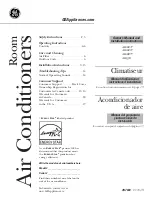
Pre-Start
RT-SVX46G-EN
41
Note:
Upon closing main power disconnect and the unit
mounted disconnect switch or circuit breaker, the
phase monitor will verify proper phasing. If LED on
face of the monitor is red, correct supply power
fault.
To prevent injury or death from electrocution, it is the
responsibility of the technician to recognize this hazard
and use extreme care when performing service
procedures with the electrical power energized.
•
Observe the ABC and CBA phase indicator lights on the
face of the sequencer. The ABC indicator light will glow
if the phase is ABC. If the CBA indicator light glows,
open the disconnect switch or circuit protection switch
and reverse any two power wires.
•
Restore the main electrical power and recheck the
phasing. If the phasing is correct, open the disconnect
switch or circuit protection switch and remove the
phase sequence indicator.
Compressor Crankcase Heaters
Each compressor can be equipped with a crankcase
heater. The proper operation of the crankcase heater is
important to maintain an elevated compressor oil
temperature during the “Off” cycle to reduce oil foaming
during compressor starts. Oil foaming occurs when
refrigerant condenses in the compressor and mixes with
the oil. In lower ambient conditions, refrigerant migration
to the compressor could increase.
When the compressor starts, the sudden reduction in
crankcase pressure causes the liquid refrigerant to boil
rapidly causing the oil to foam. This condition could
damage compressor bearings due to reduced lubrication
and could cause compressor mechanical failures.
Before starting the unit in the “Cooling” mode, set the
system switch to the “Off” position and turn the main
power disconnect to the “On” position and allow the
crankcase heater to operate a minimum of 8 hours.
Before closing the main power disconnect switch, insure
that the “System” selection switch is in the “Off” position
and the “Fan” selection switch is in the “Auto” position.
Close the main power disconnect switch and the unit
mounted disconnect switch, if applicable.
Note:
Upon closing main power disconnect and the unit
mounted disconnect switch or circuit breaker, the
phase monitor will verify proper phasing. If LED on
face of the monitor is red, correct supply power
fault.
To prevent injury or death from electrocution, it is the
responsibility of the technician to recognize this hazard
and use extreme care when performing service
procedures with the electrical power energized.
ReliaTel™ Controls
Upon power initialization, the RTRM performs self-
diagnostic checks to insure that all internal controls are
functional. It also checks the configuration parameters
against the components connected to the system. The
Liteport LED located on the RTRM module is turned “On”
within one second of power-up if internal operation is
okay.
Use one of the following “Test” procedure to bypass some
time delays and to start the unit at the control panel. Each
step of unit operation can be activated individually by
temporarily shorting across the “Test” terminals for two
to three seconds. The Liteport LED located on the RTRM
module will blink when the test mode has been initiated.
The unit can be left in any “Test” step for up to one hour
before it will automatically terminate, or it can be
terminated by opening the main power disconnect switch.
Once the test mode has been terminated, the Liteport LED
will glow continuously and the unit will revert to the
“System” control.
WARNING
Live Electrical Components!
Failure to follow all electrical safety precautions when
exposed to live electrical components could result in
death or serious injury. When necessary to work with
live electrical components, have a qualified licensed
electrician or other individual who has been properly
trained in handling live electrical components perform
these tasks.
WARNING
Live Electrical Components!
Failure to follow all electrical safety precautions when
exposed to live electrical components could result in
death or serious injury. When necessary to work with
live electrical components, have a qualified licensed
electrician or other individual who has been properly
trained in handling live electrical components perform
these tasks.
















































